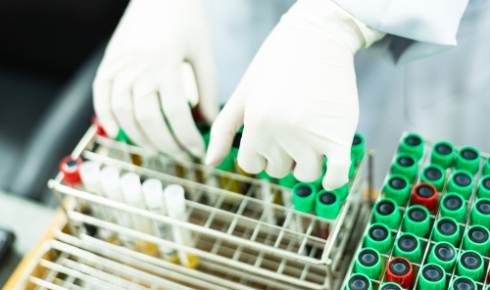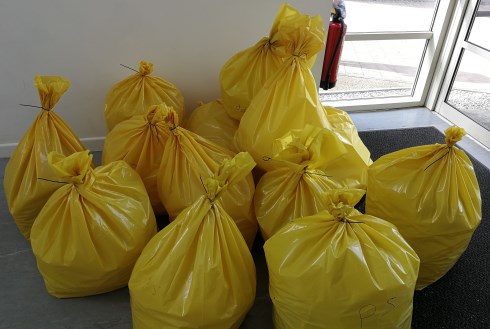How to... reduce your lab's plastic waste

David Kuntin on how he and his colleagues have cut the amount of plastic their lab sends to landfill each year by more than a tonne
The Biologist 65(6) p28-31
Biology laboratories rely heavily on single-use plastics in their day-to-day operations. In 2015, scientists from Exeter University estimated that their bioscience department was generating up to 280 tonnes of plastic waste per year. Extrapolating their laboratory’s plastic waste problem in Nature, the researchers estimated that the world’s biomedical and agricultural science laboratories could be producing more than five million tonnes of plastic waste every year.
Gone are the days of reusable glass pipettes and culture dishes – disposable plastics are regarded as more convenient and cost-effective. Unfortunately, laboratory plastics have long been deemed non-recyclable because of the nature of their contamination. Moreover, the infrastructure simply isn’t in place at most research facilities to deal sustainably with the plastics being disposed of.
Currently, contaminated cell culture plastics are bagged, autoclaved and sent to landfill. Other plastics that are not contaminated but can be identified as ‘lab waste’ – for example, plastic test tubes that have held only water – still have to be sent to landfill in special bags. Most local recycling plants won’t accept them for perceived health and safety reasons.
At the Genever Lab at the University of York’s Department of Biology, we are trialling a plastics recycling waste stream that has enabled us to reduce our landfill waste considerably. We now save up to 1,040kg of plastic a year from going to landfill – enough to fill 110 bathtubs – and the trial is set to expand. As well as decreasing our landfill waste, we have saved on costs and energy consumption by drastically reducing our autoclavable waste. We have worked hard to ensure a streamlined, convenient process, so here are some things to consider if you are attempting to reduce plastic waste in your lab.
Institutional support
It is of paramount importance that your endeavour is monitored closely and approved by your institution. There are myriad operational issues that may seem irrelevant, but that are essential to university management. If these things are not in place, it is likely that your recycling initiative will be put on hold or even scrapped.
We worked closely with environmental managers, safety advisers, and infrastructure and procurement teams to make sure every step of the recycling process was agreed and ran efficiently. Because so many people are required to ensure the smooth operation of this scheme, it is important to establish clear communication from an early stage.
What can you recycle?
You’ll need to find out whether the labware you are using is indeed made of recyclable material. There are a number of materials that your local authority will recycle, but the issue with recycling through a council waste stream is that there are huge inconsistencies across the UK in what councils will accept.
Plastics that can most commonly be recycled are polystyrene (PS), polypropylene (PP) and high-density or low-density polyethylene (HDPE/LDPE). Commonly used consumables such as centrifuge tubes are made of PP, while culture dishes and flasks are usually made of PS. HDPE and LDPE are most commonly found in lids. Details about materials are usually on the manufacturer’s website.
You need to take care with some materials, such as lids, as these often contain a rubber or paper ring within them. A lot of recycling plants won’t accept mixed materials, so it’s best to enquire about their acceptable tolerances.
Normally a university will use a specialist waste contractor, which may or may not have the capacity to deal with decontaminated laboratory plastics. Other specialist recycling companies do exist that should be able to manage your plastics recycling for a reasonable price. In our case, we have to separate out all types of plastics and bag them separately to make it cost-effective for our provider of recycling services.
Buy better
As mixed materials are difficult to recycle, a good start is to review which common consumables your laboratory is buying and what they’re made of. We have a spreadsheet set up with colour coding for each plastic. Where possible, we have switched providers of certain consumables to reduce how many different suppliers we have (to decrease the number of deliveries) and how many different plastics we have.
For example, a 100ml tube we used previously had a PP body and an HDPE lid. This would have been the only common consumable with an HDPE component, meaning we would have needed an extra bin to collect only those lids.
Furthermore, we were getting them from a supplier from which we didn’t order anything else because all we previously considered in our choice of tube was its price. Now the deliveries of this tube are being consolidated with other consumables we order and the new tubes have LDPE lids – the same material that is in all the other lids we use. This enables us to streamline our recycling collection process and makes it easier to follow as well.
Use less
We tend to plan our experiments as efficiently as possible, but we usually only consider how the experiments we carry out are set up most easily, not examining how many consumables we might use.
For example, it is common to require a small vessel, but only have very few samples and therefore have to use only part of a multiwell plate, leaving empty wells in it. It is possible to buy smaller multiwell plates with the size of well required, so if your experiments often require much less of a multiwell plate than is available, look at switching to smaller plates. You can also consider multiplexing assays or running several experiments on one plate, which is often possible. Again, glass consumables are usually the most environmentally friendly choice, so if you have the option of getting them and have the setup required for decontamination and cleaning, they would be a good option.
In another case, we switched from plastic tubes to glass ones, making them more or less infinitely reusable. Following that, we even eliminated a certain size of tube because we found that we could use a larger tube for slightly smaller volumes so there was no need to use specifically sized tubes for most of our applications.
 A month's worth of plastic waste from the Genever lab at York, bagged up and ready for recycling.
A month's worth of plastic waste from the Genever lab at York, bagged up and ready for recycling. Decontamination
Some plastics will require decontamination. In this case, there has to be a robust, monitored decontamination procedure in place to ensure that contaminated waste does not enter the disposal route. Of course, there might be a specialist company that will accept contaminated plastics, but your laboratory will have to decide whether it can justify the higher cost associated with that.
We have developed and tested a decontamination protocol and incorporated it into our training for new staff and students.
Our recycling waste stream comprises a 24-hour soak in a high-level disinfectant at our ‘decontamination station’, followed by a rinse for chemical decontamination. After that, our decontaminated waste is separated into the appropriate bins according to their plastic. This is colour coded, making it easy to follow.
Our waste is handled by our infrastructure team, which has pencilled deals with a provider that already collects our chemical waste to take our recycling waste. This means we are not adding any extra emissions from another delivery van. We have drastically reduced our autoclave waste by recycling as well, which has put a considerable dent in our energy consumption – and therefore costs.
Resistance to change
When you first suggest reducing your recycling waste, initial reactions are likely to be mixed. Researchers can easily work 40-plus hours per week and the perception is that recycling will take up more time than it does. Communications are a hurdle to overcome too, as so many parties in university management are involved in the endeavour. Laying out clear plans, with every eventuality accounted for, reduces people’s worries about the scheme and fosters openness.
Operational issues such as tenders with existing waste management companies or budgets can also hamper your progress, which is why university management, again, is a highly important resource when trying to reduce recycling waste.
Persistence is key. An organised, easy-to-follow workflow is a great way to ensure the commitment doesn’t seem overwhelming for laboratory workers. Raising awareness of the larger impact often helps, although in reality it can be difficult to convince people of this truth. Generally, though, once a system is in place, people tend to follow suit, so a good way of implementing a recycling scheme is to do just that: implement it.
Now is the time to do it
Regardless of the purpose of our work, our environmental impact cannot be denied and it cannot be completely excused. Researchers produce enough plastic waste to warrant seriously considering mitigating its impact. Our laboratory has made progress, but the only way to gain real traction on a larger scale is to campaign for change and to educate about not only the environmental benefits, but also its cost-effectiveness, which is something people tend to overlook.
As scientists we have a duty to educate and to conduct ourselves responsibly. By markedly cutting down on our landfill waste, we believe we have made an important, achievable step in the right direction.
David Kuntin MRSB is studying for a PhD at the Genever Lab at the University of York. His research is focused on biocompatible surfaces for medical implants. He is also a member of his department’s environmental protection group.


